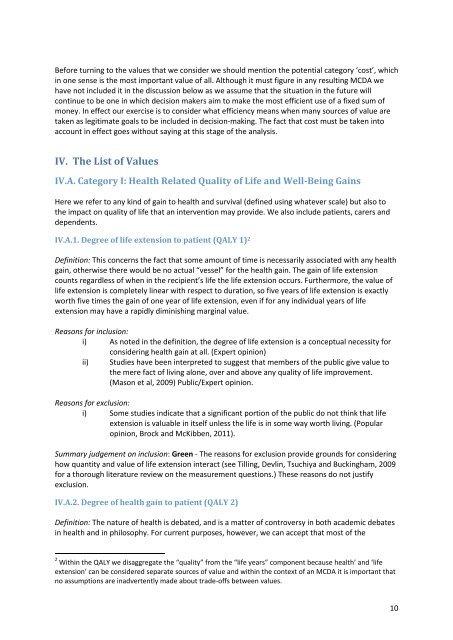What Values Should Count in Value Based Pricing for the NHS - UCL
What Values Should Count in Value Based Pricing for the NHS - UCL
What Values Should Count in Value Based Pricing for the NHS - UCL
You also want an ePaper? Increase the reach of your titles
YUMPU automatically turns print PDFs into web optimized ePapers that Google loves.
Be<strong>for</strong>e turn<strong>in</strong>g to <strong>the</strong> values that we consider we should mention <strong>the</strong> potential category ‘cost’, which<br />
<strong>in</strong> one sense is <strong>the</strong> most important value of all. Although it must figure <strong>in</strong> any result<strong>in</strong>g MCDA we<br />
have not <strong>in</strong>cluded it <strong>in</strong> <strong>the</strong> discussion below as we assume that <strong>the</strong> situation <strong>in</strong> <strong>the</strong> future will<br />
cont<strong>in</strong>ue to be one <strong>in</strong> which decision makers aim to make <strong>the</strong> most efficient use of a fixed sum of<br />
money. In effect our exercise is to consider what efficiency means when many sources of value are<br />
taken as legitimate goals to be <strong>in</strong>cluded <strong>in</strong> decision‐mak<strong>in</strong>g. The fact that cost must be taken <strong>in</strong>to<br />
account <strong>in</strong> effect goes without say<strong>in</strong>g at this stage of <strong>the</strong> analysis.<br />
IV. The List of <strong><strong>Value</strong>s</strong><br />
IV.A. Category I: Health Related Quality of Life and Well‐Be<strong>in</strong>g Ga<strong>in</strong>s<br />
Here we refer to any k<strong>in</strong>d of ga<strong>in</strong> to health and survival (def<strong>in</strong>ed us<strong>in</strong>g whatever scale) but also to<br />
<strong>the</strong> impact on quality of life that an <strong>in</strong>tervention may provide. We also <strong>in</strong>clude patients, carers and<br />
dependents.<br />
IV.A.1. Degree of life extension to patient (QALY 1) 2<br />
Def<strong>in</strong>ition: This concerns <strong>the</strong> fact that some amount of time is necessarily associated with any health<br />
ga<strong>in</strong>, o<strong>the</strong>rwise <strong>the</strong>re would be no actual “vessel” <strong>for</strong> <strong>the</strong> health ga<strong>in</strong>. The ga<strong>in</strong> of life extension<br />
counts regardless of when <strong>in</strong> <strong>the</strong> recipient’s life <strong>the</strong> life extension occurs. Fur<strong>the</strong>rmore, <strong>the</strong> value of<br />
life extension is completely l<strong>in</strong>ear with respect to duration, so five years of life extension is exactly<br />
worth five times <strong>the</strong> ga<strong>in</strong> of one year of life extension, even if <strong>for</strong> any <strong>in</strong>dividual years of life<br />
extension may have a rapidly dim<strong>in</strong>ish<strong>in</strong>g marg<strong>in</strong>al value.<br />
Reasons <strong>for</strong> <strong>in</strong>clusion:<br />
i) As noted <strong>in</strong> <strong>the</strong> def<strong>in</strong>ition, <strong>the</strong> degree of life extension is a conceptual necessity <strong>for</strong><br />
consider<strong>in</strong>g health ga<strong>in</strong> at all. (Expert op<strong>in</strong>ion)<br />
ii) Studies have been <strong>in</strong>terpreted to suggest that members of <strong>the</strong> public give value to<br />
<strong>the</strong> mere fact of liv<strong>in</strong>g alone, over and above any quality of life improvement.<br />
(Mason et al, 2009) Public/Expert op<strong>in</strong>ion.<br />
Reasons <strong>for</strong> exclusion:<br />
i) Some studies <strong>in</strong>dicate that a significant portion of <strong>the</strong> public do not th<strong>in</strong>k that life<br />
extension is valuable <strong>in</strong> itself unless <strong>the</strong> life is <strong>in</strong> some way worth liv<strong>in</strong>g. (Popular<br />
op<strong>in</strong>ion, Brock and McKibben, 2011).<br />
Summary judgement on <strong>in</strong>clusion: Green ‐ The reasons <strong>for</strong> exclusion provide grounds <strong>for</strong> consider<strong>in</strong>g<br />
how quantity and value of life extension <strong>in</strong>teract (see Till<strong>in</strong>g, Devl<strong>in</strong>, Tsuchiya and Buck<strong>in</strong>gham, 2009<br />
<strong>for</strong> a thorough literature review on <strong>the</strong> measurement questions.) These reasons do not justify<br />
exclusion.<br />
IV.A.2. Degree of health ga<strong>in</strong> to patient (QALY 2)<br />
Def<strong>in</strong>ition: The nature of health is debated, and is a matter of controversy <strong>in</strong> both academic debates<br />
<strong>in</strong> health and <strong>in</strong> philosophy. For current purposes, however, we can accept that most of <strong>the</strong><br />
2 With<strong>in</strong> <strong>the</strong> QALY we disaggregate <strong>the</strong> “quality” from <strong>the</strong> “life years” component because health’ and ‘life<br />
extension’ can be considered separate sources of value and with<strong>in</strong> <strong>the</strong> context of an MCDA it is important that<br />
no assumptions are <strong>in</strong>advertently made about trade‐offs between values.<br />
10
















